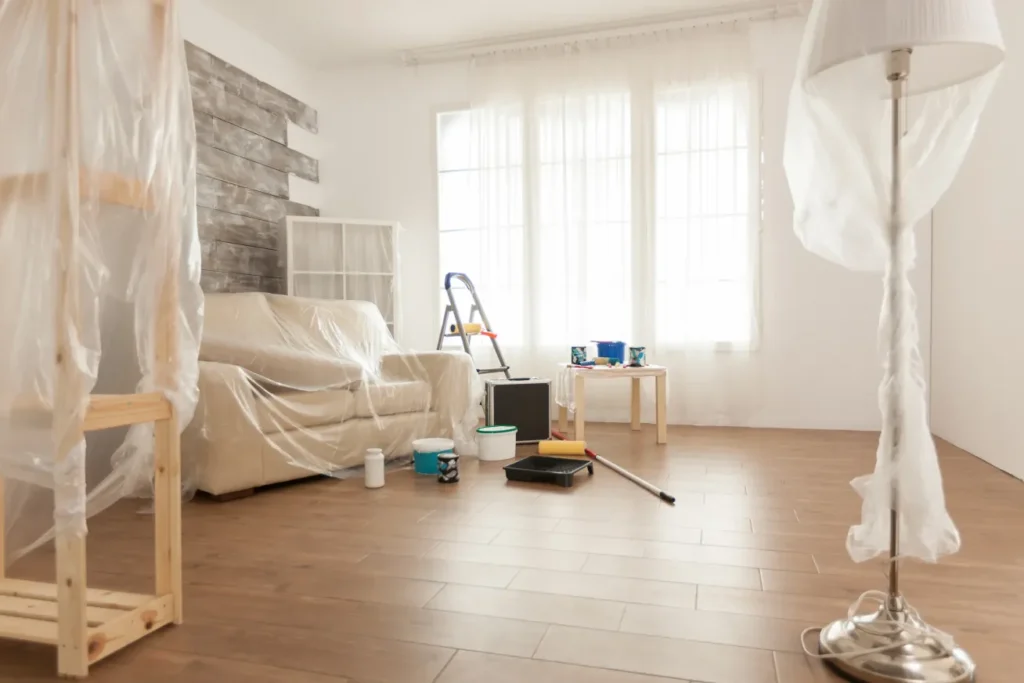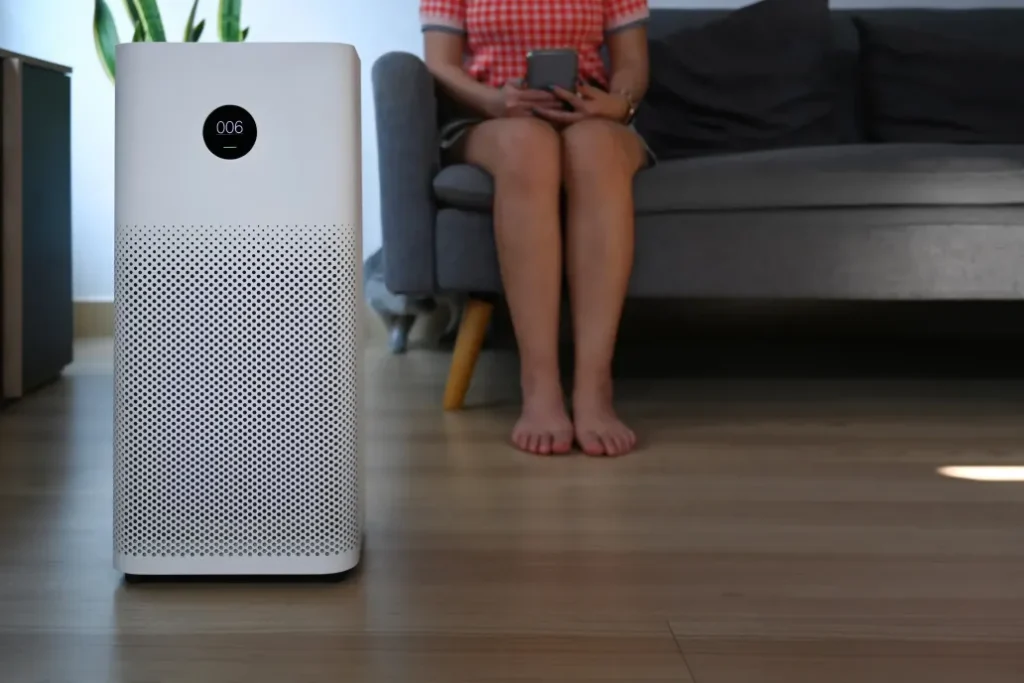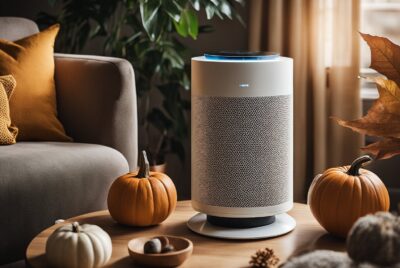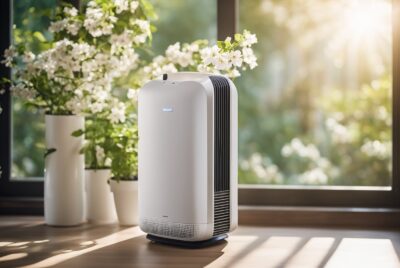Understanding the Role of Air Purifiers in Combating Lead Dust
TL;DR
Equip your home with an air purifier specifically designed for lead dust to safeguard your family’s health. These purifiers effectively reduce the risk of lead poisoning, particularly in children, by filtering out toxic lead particles from your indoor environment.
Embrace a proactive approach to clean air and peace of mind with the right air purifier.
As an enthusiast and advisor in the field of air quality, I’ve come to understand the silent, invisible threats that can pose serious health risks to us and our loved ones. One such threat is lead dust.
In this guide, I’ll take you through the dangers of lead dust, its impact on our health, and how an air purifier for lead dust can help protect your family.
We’ll explore the sources of lead dust, the symptoms of lead poisoning, and the particular threat it poses to children. I’ll also share some helpful suggestions and reasons for using air purifiers and making certain indoor upgrades to safeguard your home.
Let’s dive in and learn how to create a safer, healthier environment for our families.
Understanding Lead Dust
Lead dust is a serious concern in homes, particularly those with older paint or contaminated soil. It can be invisible to the naked eye but poses a significant risk to children’s health.
To effectively mitigate this risk, it is crucial to have a proper understanding of how lead dust forms and spreads.
Sources of Lead Dust
Lead dust can originate from various sources, including air filtration systems and products. It’s often invisible to the naked eye, making it a stealthy health hazard. Here are some common sources of danger.
| Source | Associated Risks | Preventive Measures |
|---|---|---|
| Deteriorating lead-based paint | Lead dust creation | Maintain paint, and address deterioration promptly |
| Home renovations | Spread of lead dust | Use safe practices during renovations |
| Contaminated soil | Exposure during play | Be cautious of play areas in urban or industrial areas |
| Imported goods | Lead contamination | Research before buying imported goods |
Symptoms of Lead Poisoning
Lead poisoning can cause a variety of symptoms, and in severe cases, it can even be fatal. As a concerned individual, I believe it’s important to recognize these symptoms early. Here are some common symptoms of lead poisoning:
- Developmental delay: Children exposed to lead may show signs of developmental delay. This could include not reaching developmental milestones at the expected age.
- Learning difficulties: Lead poisoning can affect a child’s ability to learn. They may struggle with reading, writing, and math.
- Irritability: Children with lead poisoning may become irritable. They may have difficulty concentrating and may show signs of hyperactivity.
- Loss of appetite and weight loss: Lead poisoning can cause a loss of appetite, leading to weight loss. If your child suddenly loses interest in food or starts losing weight, it could be a sign of lead poisoning.
- Sluggishness and fatigue: Lead poisoning can cause a child to feel tired and sluggish. They may lack energy and not want to engage in their usual activities.
- Abdominal pain: Lead poisoning can cause abdominal pain, constipation, and nausea.
If you notice any of these symptoms in your child, it’s important to consult a healthcare provider immediately. They can conduct a blood test to check for lead poisoning. Remember, early detection and intervention can make a significant difference in the outcome.

The Threat of Lead Dust to Children
As a parent, I understand the constant worry about the safety and health of our children. One of the invisible threats that often goes unnoticed is lead dust. It’s a silent enemy that can have serious implications for our little ones.
Lead dust is particularly dangerous because it’s often invisible and can easily be ingested or inhaled by children during their regular activities. Kids are naturally curious and love to explore their surroundings, often putting their hands or toys in their mouths, which can lead to unintentional ingestion of lead dust.
How Children are Exposed to Lead Dust
Children can be exposed to lead dust in several ways:
| Exposure Method | Description | Preventive Measures |
|---|---|---|
| Playing on the floor | Lead dust settles on the floor | Regular cleaning of floors |
| Renovations | Disturbing lead-based paint | Safe renovation practices |
| Imported goods | Contaminated toys or jewelry | Caution with toys and jewelry |
It’s important to be aware of these sources and take steps to minimize exposure. This can include regular cleaning, safe renovation practices, and being cautious about the toys and jewelry your child uses.
The Impact of Lead Poisoning on Children
Lead poisoning can have serious effects on a child’s development. Here are some of the potential impacts:
- Developmental delay: Lead poisoning can slow down a child’s growth and development, leading to issues like learning difficulties and behavioral problems.
- Neurological effects: Lead can affect a child’s nervous system, leading to problems with concentration and memory.
- Physical symptoms: Lead poisoning can also cause physical symptoms like abdominal pain, constipation, and loss of appetite.
It’s heartbreaking to think of our children suffering from these effects. That’s why it’s so important to take steps to protect them from lead dust exposure. This can include using an air purifier, regular cleaning, and safe renovation practices.
Minimizing Exposure for Protection
Minimizing exposure to lead dust is crucial for protecting children from its detrimental effects. Here are some practical steps parents and caregivers can take:
- Regularly clean floors and windowsills using wet methods (damp mop or sponge) to prevent the spread of lead dust.
- Frequently wash children’s hands, toys, and pacifiers to remove any potential lead particles.
- Ensure that children have a clean play area free from lead-contaminated dust or soil.
- Avoid using old toys or antique items that may contain lead-based paint.
- If renovating an older home, take precautions such as sealing off work areas and using professional contractors trained in lead-safe practices.
By understanding the threat of lead dust and taking proactive steps, we can create a safer environment for our children. Remember, prevention is always better than cure, especially when it comes to something as serious as lead poisoning.

The Role of Air Purifiers in Combating Lead Dust
As someone who’s spent a considerable amount of time researching and understanding the impact of indoor air quality on health, I can’t stress enough the importance of air purifiers in combating lead dust. Let’s delve deeper into this topic.
How Air Purifiers Work
Air purifiers are quite fascinating when you get to know them. They operate on a simple principle – draw in air from your environment, pass it through a series of filters to remove pollutants, and then circulate the purified air back into the room.
| Filter Type | Function |
|---|---|
| Pre-filter | Captures larger particles like hair and dust |
| HEPA filter | Captures 99.97% of particles 0.3 microns or larger |
| Activated carbon filter | Removes odors and gases |
Remember, not all air purifiers are created equal. Some models may have additional features like UV-C lights to kill germs or ionizers to help capture more particles. When it comes to air purifiers for lead dust, the best option is a HEPA air purifier. The best HEPA air purifier for lead dust will effectively remove harmful particles from the air.
Can Air Purifiers Remove Lead Dust?
The million-dollar question – can air purifiers remove lead dust? The answer is yes but with a caveat. Not all air purifiers are capable of this feat. You need a model with a True HEPA filter. These filters are certified to remove 99.97% of particles that are 0.3 microns or larger, which includes lead dust.
Here’s why I recommend using an air purifier for lead dust:
- Efficiency: A True HEPA air purifier can capture most of the lead dust particles in your environment. It’s a passive solution that works 24/7, providing constant protection for your family.
- Health: By reducing the amount of lead dust in your environment, you’re reducing your family’s exposure to this dangerous pollutant. This can help prevent lead poisoning and its associated health problems.
- Peace of mind: Knowing that you’re actively protecting your family’s health can provide a great deal of peace of mind.
However, it’s important to remember that an air purifier is not a complete solution. It should be used in conjunction with other measures, like regular cleaning and safe renovation practices, to minimize lead dust exposure.
Indoor Upgrades to Protect Against Lead Dust
As someone who’s experienced the challenges of dealing with lead dust, I can’t stress enough the importance of making indoor upgrades to protect against this invisible threat. It’s not just about purchasing an air purifier; there are several other steps you can take to ensure your home is as safe as possible.
Choosing the Right Air Purifier
Selecting the right air purifier is a crucial step in your fight against lead dust. Here are some factors you should consider:
- Filter Type: Not all air purifiers are created equal. Look for one with a True HEPA filter. These filters are certified to remove 99.97% of particles that are 0.3 microns or larger, which includes lead dust.
- Room Size: Consider the size of the room where you’ll be using the air purifier. The effectiveness of air purifiers in removing lead dust can be significantly reduced if they are not powerful enough for the size of the room.
- CADR Rating: The Clean Air Delivery Rate (CADR) is a measure of the purifier’s cleaning speed. A higher CADR means the purifier can clean a larger volume of air more quickly.
- Noise Level: Since you’ll likely be running your air purifier for extended periods, consider the noise level. Many high-quality air purifiers operate quietly, ensuring they don’t become a nuisance.
Installing Smooth Surfaces
Another effective way to minimize the accumulation and spread of lead particles within your house is by installing smooth surfaces that are easy to clean. Surfaces such as walls, floors, and countertops should be free from cracks, crevices, or textured finishes that could harbor dust particles. Smooth surfaces make cleaning more efficient and reduce the risk of lead contamination.
Regularly maintaining painted surfaces is also crucial in minimizing the risk of chipping or peeling, which could release hazardous dust into the air. Here are some tips for maintaining painted surfaces:
- Inspect Regularly: Routinely check for signs of peeling, cracking, or chipping paint on walls, doors, and windows.
- Repair Promptly: If you notice any damage, promptly repair it using lead-safe practices. This may involve hiring professional contractors trained in lead-safe renovation techniques.
- Clean Gently: When cleaning painted surfaces, use mild soap and water or specialized lead dust cleaners to avoid damaging the paint or releasing more dust into the air.
- Avoid Dry Sanding: Refrain from dry sanding as it can create fine lead dust particles that are easily inhaled.
Upgrading Ventilation Systems
Proper ventilation is essential for maintaining good indoor air quality and reducing the concentration of pollutants like lead dust. Consider implementing the following strategies to enhance ventilation in your home and determine if air purifiers help with lead dust.
- Exhaust Fans: Install exhaust fans in kitchens and bathrooms to remove airborne contaminants generated during cooking or bathing.
- Airflow Optimization: Ensure proper airflow throughout your house by keeping interior doors open and unobstructed.
- Fresh Air Intake: If feasible, consider installing a fresh air intake system that brings clean outdoor air into your home while expelling stale indoor air.
Other Indoor Upgrades
Beyond air purifiers, there are several other indoor upgrades you can make to protect against lead dust:
- Regular Cleaning: Regularly clean your floors, window sills, and other surfaces with a damp mop or cloth. This can help reduce the amount of lead dust in your home.
- HEPA Vacuum: Use a vacuum with a HEPA filter to clean carpets and upholstery. These vacuums can capture smaller particles, including lead dust.
- Sealing Off Areas: If you have areas in your home with deteriorating lead-based paint, consider sealing them off, especially if they’re frequently used by children.
- Replacing Windows: Old windows can be a significant source of lead dust. If possible, consider replacing them with new, lead-free windows.
Remember, the fight against lead dust is a continuous process. It’s not just about making a few upgrades and forgetting about it. Regular cleaning, proper maintenance of your air purifier, and staying informed about the sources and dangers of lead dust are all crucial parts of protecting your family’s health.

Easy Steps to Reduce Lead Dust with Air Purifiers
Air purifiers can be an effective tool in reducing lead dust levels in your home. By following these easy steps, you can create a healthier environment for yourself and your family.
Regular Cleaning
Regular cleaning is one of the most effective ways to reduce lead dust in your home. Here’s a detailed breakdown of how I approach this:
- Daily Dusting: I make it a point to dust surfaces daily using a damp cloth. This helps to capture the dust instead of spreading it around. It’s important to remember that dry dusting can stir up lead particles into the air.
- Weekly Vacuuming: Every week, I vacuum all carpets, rugs, and upholstery using a vacuum cleaner equipped with a HEPA filter. These filters are designed to capture small particles, including lead dust.
- Mopping Floors: After vacuuming, I mop the floors with a damp mop. This helps to pick up any dust that the vacuum may have missed.
- Cleaning Toys and Pacifiers: If you have young children, it’s crucial to clean their toys and pacifiers regularly. Children often put these items in their mouths, so keeping them clean can help to prevent ingestion of lead dust.
The reason regular cleaning is so effective is that it physically removes lead particles from your home. By keeping surfaces dust-free, you’re reducing the chance of lead dust being ingested or inhaled.
Safe Renovation Practices
If you’re living in an older home, there’s a chance that lead-based paint was used in its construction. Renovations or repairs can disturb this paint, releasing lead dust into your home. Here’s how I ensure safe renovation practices:
- Hire Certified Professionals: When I need to renovate, I always hire professionals who are certified in lead-safe practices. They have the training to handle lead-based paint safely and to clean up thoroughly afterward.
- Seal Off the Area: During renovations, I make sure the work area is sealed off from the rest of the house. This prevents lead dust from spreading to other areas.
- Use Protective Gear: If I’m doing any work myself, I always wear protective gear, including a mask and gloves. This helps to prevent inhalation or ingestion of lead dust.
- Thorough Clean-up: After any renovation work, I ensure a thorough clean-up. This includes using a HEPA vacuum to remove dust and washing all surfaces with a damp cloth.
The reason these practices are so important is that they prevent the spread of lead dust during renovations. By containing the dust and cleaning up thoroughly, you can significantly reduce the risk of lead exposure.
Run Air Purifiers Continuously
To maintain consistently low levels of lead dust in your home, it’s important to run the air purifiers continuously. This ensures that any newly generated or disturbed lead dust is promptly captured and filtered out of the air.
Consider investing in air purifiers with multiple filtration stages for optimal performance. Look for models that include a pre-filter to capture larger particles and a second-stage filter specifically designed for removing smaller contaminants like lead dust. Regularly clean and replace the filters in your air purifiers to maintain their effectiveness.
The Benefits of Using Air Purifiers for Lead Dust Protection
Air purifiers provide an additional layer of defense against lead dust, complementing other preventive measures. These devices are designed to filter out harmful particles from the air, including lead dust, ensuring cleaner and safer indoor environments.
Using air purifiers can help create a healthier indoor environment by reducing the concentration of harmful airborne particles. Lead dust is particularly dangerous when it is inhaled or ingested, as it can lead to various health issues, especially in children.
By using air purifiers specifically designed for lead dust removal, you can significantly reduce the risk of exposure to this hazardous substance.
One of the significant advantages of using air purifiers for lead dust protection is the peace of mind they offer. As a parent or guardian, ensuring the well-being and safety of your children is always a top priority.
By incorporating air purifiers into your home, you actively work towards safeguarding their health. Knowing that you have taken proactive steps to minimize their exposure to lead dust can alleviate concerns and provide reassurance.
There are several pros worth considering:
- Efficiency: Air purifiers equipped with high-efficiency particulate air (HEPA) filters are highly effective at capturing even the tiniest particles, including lead dust. These filters have been proven to remove up to 99.97% of airborne contaminants.
- Continuous Filtration: Unlike manual cleaning methods that may miss certain areas or require regular maintenance, air purifiers operate continuously to filter out lead dust particles from the air throughout your home.
- Convenience: Air purifiers are easy to use and require minimal effort on your part. Simply plug them in and let them do their job silently in the background while you go about your daily activities.
- Versatility: Air purifiers come in various sizes and designs suitable for different spaces. Whether you need one for a small bedroom or a larger living area, there are options available to meet your specific needs.
- Long-term Cost Savings: While the initial investment in an air purifier may seem significant, it can save you money in the long run. By reducing the concentration of lead dust particles in your home, air purifiers can potentially prevent health issues that would require costly medical treatments.

Wrapping Up: Your Guide to a Lead Dust-Free Home
Protecting children from lead poisoning is of utmost importance, and one effective way to combat lead dust is by using air purifiers. These devices play a crucial role in safeguarding the health and well-being of children exposed to lead dust.
By understanding the dangers posed by lead dust, recognizing the need for indoor upgrades, and following easy steps to reduce lead dust with air purifiers, parents can significantly reduce the risk of lead poisoning.
Air purifiers offer numerous benefits. They efficiently filter out harmful particles, including lead dust, from indoor air, ensuring cleaner and healthier environments for children.
By choosing the right air purifier specifically designed for lead dust removal, parents can enhance their child’s safety and well-being.
Frequently Asked Questions (FAQs)
No, while air purifiers can significantly reduce the amount of lead dust in your environment, they cannot remove 100% of it. It’s important to combine the use of an air purifier with other measures, like regular cleaning and safe renovation practices.
Yes, an air purifier can help with cat litter dust. It works by drawing in air from the room, filtering out dust particles including those from cat litter, and then releasing the clean air back into the room. However, it’s important to choose a purifier with a HEPA filter for the best results.
Absolutely! Air purifiers are designed to filter out various particles from the air, including dust. They can significantly reduce the amount of dust in your home, leading to cleaner air and less dust on your furniture.
While air purifiers are very effective, you can also reduce dust by regularly cleaning your home, using a vacuum with a HEPA filter, keeping windows closed on windy days, and using dust-mite-proof covers on bedding and upholstered furniture.
Besides using an air purifier, you can also keep your home clean, maintain a good level of humidity, use air conditioning during pollen season, avoid smoking indoors, and use natural air purifiers like indoor plants.
While air purifiers are highly effective at reducing airborne particles, it is important to note that they cannot eliminate all traces of lead dust. Regular cleaning and maintenance alongside other preventive measures are necessary for comprehensive protection against exposure.
When selecting an air purifier for removing lead dust, consider models with HEPA filters certified to capture fine particles smaller than 0.3 microns. Look for units with high Clean Air Delivery Rates (CADR) and adequate coverage area for your space.
Air purifiers primarily target airborne particles, including lead dust present in indoor air. However, they do not address lead contamination from sources such as soil or water. It is essential to identify and address the specific source of lead contamination for comprehensive protection.
The frequency of filter replacement depends on factors such as the model of your air purifier, usage patterns, and the level of pollutants in your environment. Generally, filters should be replaced every 6-12 months, but it is recommended to follow the manufacturer’s guidelines and replace filters as instructed to maintain optimal performance.
While it’s difficult to prevent lead dust exposure completely, you can significantly reduce it by using an air purifier, regular cleaning, and safe renovation practices.
If you suspect your child has been exposed to lead dust, it’s important to get them tested for lead poisoning. Consult your healthcare provider for advice.






Excellent article. I have lead and mercury in my body and am currently going through chelation to remove these dangerous metals. All going well until my last urine test (it’s better than a blood test) showed lead went back up some. Our house was built in 1971 so have arranged to have the house inspected and will likely seal to lead pain that’s inside the house or if recommended remove and repaint. I’m 75 and spent more than half my life overseas so lead paint is likely the initial cause of lead in my body. All of us old folks should test for heavy metals in our bodies and do what we can to remove them from our bodies. – Thanks for the article.
Thank you for sharing your experience and insights on this important topic. It’s great to hear that you’re taking proactive steps to address the lead and mercury levels in your body through chelation therapy. Your story highlights the importance of being aware of potential lead exposure, especially for those who have lived in older homes or spent time in countries where lead-based paint may have been more prevalent.
Your decision to have your house inspected for lead paint is a wise one. Sealing or removing lead-based paint can help reduce the risk of further exposure, which is crucial for maintaining your health. It’s also a good reminder for others living in older homes to consider testing for lead and taking appropriate precautions.
Your suggestion for older individuals to test for heavy metals in their bodies is valuable advice. As we age, the cumulative effects of long-term exposure to toxins like lead and mercury can become more apparent. By identifying and addressing these issues, we can take steps to improve our overall health and well-being.
Thank you again for sharing your personal experience and raising awareness about the importance of testing for and removing heavy metals from our bodies and environments. Your insights are a valuable addition to the article and may inspire others to take action in protecting their health.
Wishing you all the best with your chelation therapy and home improvements. Stay healthy and keep up the great work!